Click here to go to the online manual for the Bridge12 QLP Probe
Take a look at these two articles published by the group of Prof. Sunil Saxena using the Bridge12 QLP-1.6 for PELDOR/DEER and DQC measurements:
- Hasanbasri, Zikri, Nicholas A. Moriglioni, and Sunil Saxena. “Efficient Sampling of Molecular Orientations for Cu(II)-Based DEER on Protein Labels.” Physical Chemistry Chemical Physics, March 15, 2023. https://doi.org/10.1039/D3CP00404J.
- Mandato, Alysia, Zikri Hasanbasri, and Sunil Saxena. “Double Quantum Coherence ESR at Q-Band Enhances the Sensitivity of Distance Measurements at Submicromolar Concentrations.” The Journal of Physical Chemistry Letters 14, no. 40 (October 12, 2023): 8909–15. https://doi.org/10.1021/acs.jpclett.3c02372.
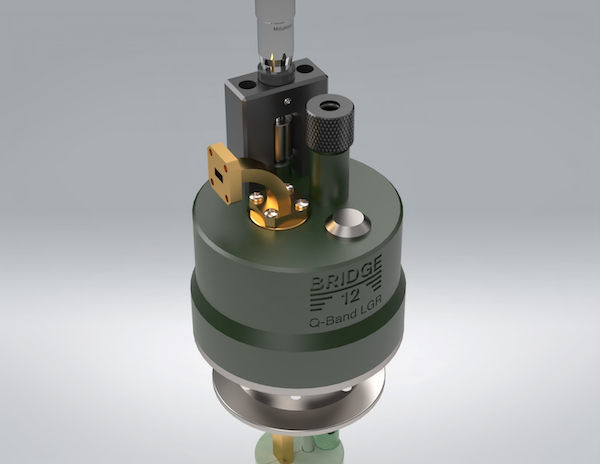
Bridge12 Q-Band LGR
The Bridge12 Q-Band resonator (B12TQLP) is optimized for pulsed dipolar EPR spectroscopy (e.g. DEER/PELDOR, SIFTER, RIDME, DQC, etc) in cases where the sample amount is limited. The resonator can be operated from 2 K to room-temperature and is compatible with standard cryostats such as the Oxford Instruments CF935 or the Cryogen Ltd. Cryogen-Free Cryostat. The resonator is connected to the spectrometer using a standard WR-28 waveguide coupling. For pulsed EPR experiments the coupling is adjusted using a micrometer screw, no frequency adjustments are necessary when changing the resonator coupling from critical to overcoupled.
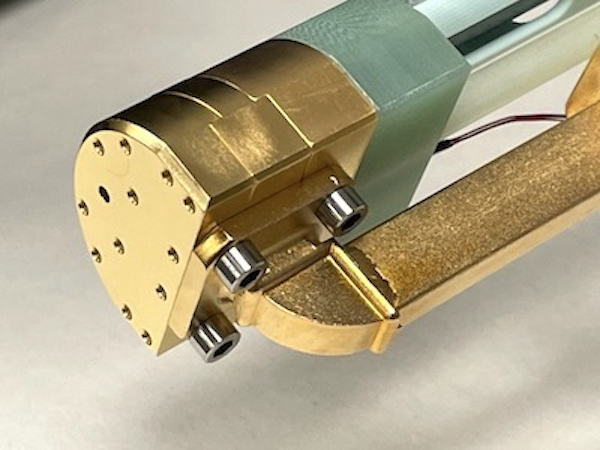
Compact Resonator
The Bridge12 B12TQLP was designed with small samples in mind. The resonator accepts standard Q-Band sample tubes with an OD of 1.6 mm (e.g. Wilmad WG-221T-RB).
The sample is mounted on a sample stick for easy inserting of the sample into the resonator and removing, even if the sample needs to stay frozen at all times.
For accurate temperature readings a temperature sensor is mounted right next to the sample space. The sensor is compatible with many commercially available temperature controllers. Instead of relying on the cryostat temperature, this will give more accurate readings of the actual sample temperature.
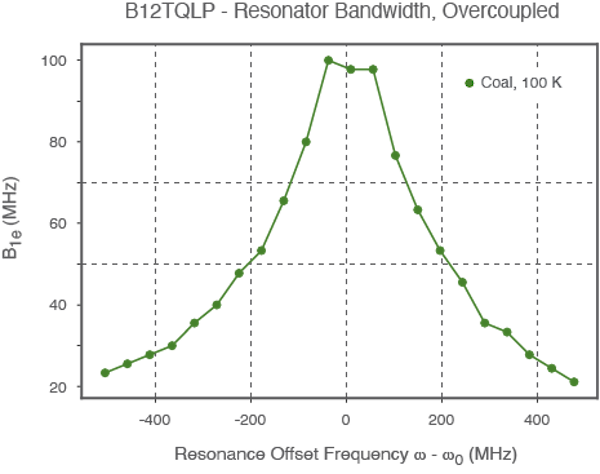
Data courtesy of Dr. Alberto Collauto, PEPR Facility, Imperial College London, UK (Pmax = 300 W, 7 dB att., ~1 dB loss)
Large Bandwidth …
Using the micrometer screw on top of the resonator to adjust the iris position, the resonator can be completely overcoupled. Critically coupled, the B12TQLP has a loaded Q of ~ 400, corresponding to a bandwidth of 85 MHz. By changing the iris the resonator Q can be lowered to < 85, increasing the resonator bandwidth to > 400 MHz. The resonator coupling is designed with convenience in mind and the maximum bandwidth can be reliably achieved every time. Even at this low Q, the microwave conversion factor is > 5.1 G/sqrt(W).
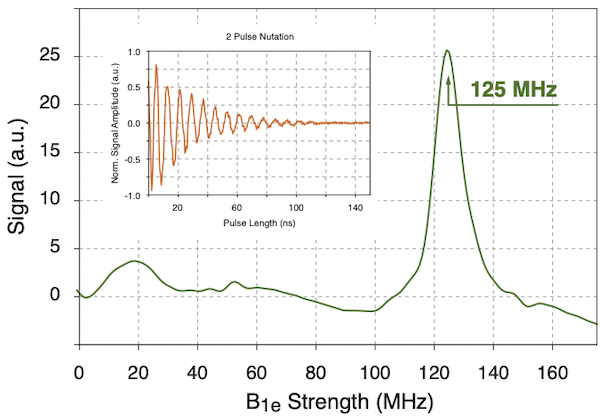
Sample: BDPA/PS. Data courtesy of Prof. Song-I Han, UCSB, (Pmax = 300 W, tp(90) = 2 ns, 6 dB att., ~1 dB loss)
… and large B1e Fields
LGRs are known for their large microwave conversion factors. The Bridge12 QLP resonator can achieve B1e field strengths of > 125 MHz, even when the resonator is completely overcoupled (bandwidth > 400 MHz). This will allow for 1H ESEEM/HYSCORE measurements and any experiment that requires hard microwave pulses.
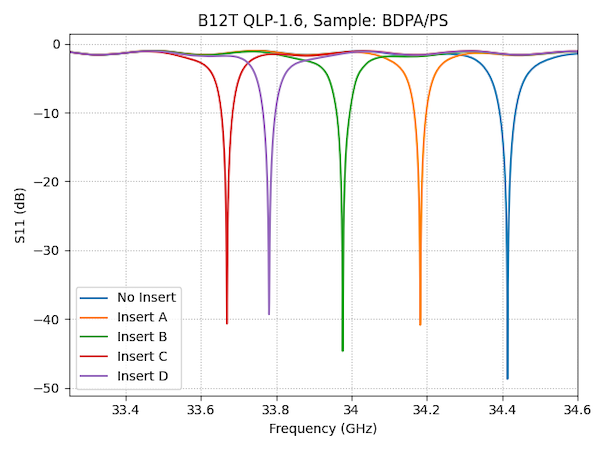
Resonator Tuning
Different samples have different dielectric constant, which will shift the resonance frequency of the probe. To accommodate a broad range of sample materials, the resonance frequency of the Bridge12 QLP can be adjusted by the user by almost 1 GHz. For this, each resonator comes with a range of tune inserts that can easily be changed by the user.
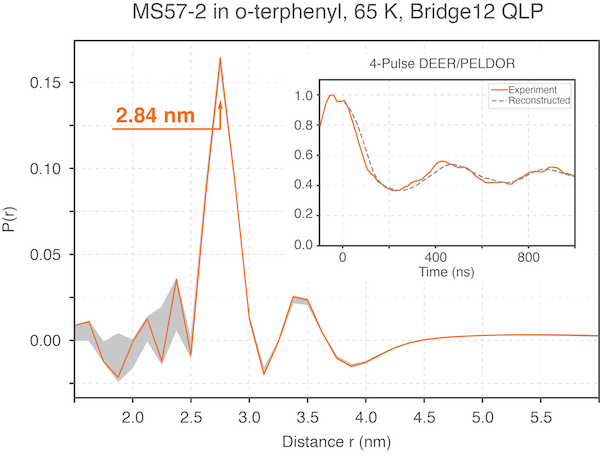
Sample: MS57-2/o-Terphenyl, 65 K.
Data courtesy of Prof. Song-I Han, UCSB
4-Pulse DEER/PELDOR Experiments
The Bridge12 QLP resonator was developed for dipolar pulsed EPR experiments (DEER/PELDOR, DQC …). The resonators large excitation bandwidth and microwave conversion factor guarantees high sensitivity and results in short acquisition times (data analyzed using the SVD method, Madhur Srivastava (Cornell University) as described here).
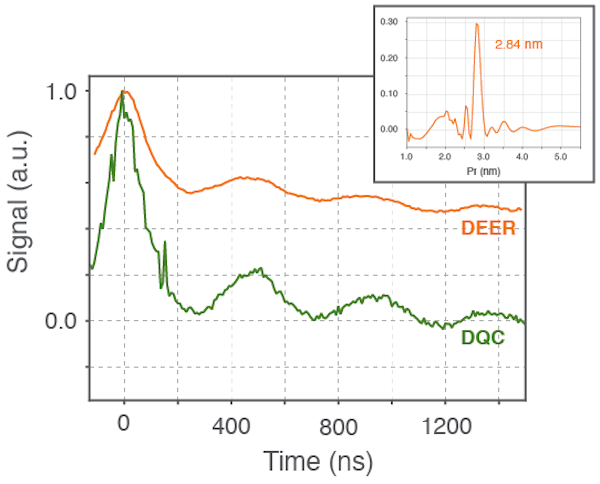
Sample: MS57-2/o-Terphenyl, 65 K.
Data courtesy of Prof. Song-I Han, UCSB
Ideal for DQC Experiments
For DQC experiments, the entire EPR spectrum has to be excited. At Q-Band, the TEMPO spectrum has a widht of ~ 250 MHz. The Bridge12 QLP resonator is ideally suited for these type of experiments. With a bandwidth of > 400 MHz and a large microwave conversion factor the entire spectrum can be excited for DQC spectroscopy.
Click here to go to the online manual for the Bridge12 QLP Probe
The Bridge12 QLP resonator was developed under a Small Business Innovation Research (SBIR) Grant by the National Institute of General Medical Sciencies (NIGMS) of the National Institutes of Health (NIH).
General References
Below, find some general literature references for dipolar spectroscopy and the required instrumentation.
- Reviews/Books:
- Goldfarb, Daniella. “Pulse EPR in Biological Systems – Beyond the Expert’s Courtyard.” Journal of Magnetic Resonance 306 (September 2019): 102–8. https://doi.org/10.1016/j.jmr.2019.07.038.
- Tsvetkov, Yuri D., Michael Bowman, and Yuri Grishin. Pulsed Electron–Electron Double Resonance: Nanoscale Distance Measurement in the Biological, Materials and Chemical Sciences. Springer International Publishing, 2019. https://doi.org/10.1007/978-3-030-05372-7.
- Jeschke, Gunnar. “DEER Distance Measurements on Proteins.” Annual Review of Physical Chemistry 63, no. 1 (2012): 419–46. https://doi.org/10.1146/annurev-physchem-032511-143716.
- Double-Quantum Coherence Spectrosocpy:
- Borbat, Petr P., and Jack H. Freed. “Multiple-Quantum ESR and Distance Measurements.” Chemical Physics Letters 313, no. 1–2 (November 1999): 145–54. https://doi.org/10.1016/S0009-2614(99)00972-0.
- PELDOR:
- Milov, A. D., A. B. Ponomarev, and Yu. D. Tsvetkov. “Electron-Electron Double Resonance in Electron Spin Echo: Model Biradical Systems and the Sensitized Photolysis of Decalin.” Chemical Physics Letters 110, no. 1 (September 14, 1984): 67–72. https://doi.org/10.1016/0009-2614(84)80148-7.
- SIFTER:
- Jeschke, G., M. Pannier, A. Godt, and H. W. Spiess. “Dipolar Spectroscopy and Spin Alignment in Electron Paramagnetic Resonance.” Chemical Physics Letters 331, no. 2 (December 1, 2000): 243–52. https://doi.org/10.1016/S0009-2614(00)01171-4.
- Q-Band LGR Resonators
- Denysenkov, Vasyl, Philipp van Os, and Thomas F. Prisner. “Q-Band Loop-Gap Resonator for EPR Applications with Broadband-Shaped Pulses.” Applied Magnetic Resonance 48 (December 1, 2017): 1263–72. https://doi.org/10.1007/s00723-017-0930-9.
- Tschaggelar, Rene, Frauke D. Breitgoff, Oliver Oberhänsli, Mian Qi, Adelheid Godt, and Gunnar Jeschke. “High-Bandwidth Q-Band EPR Resonators.” Applied Magnetic Resonance 48 (December 1, 2017): 1273–1300. https://doi.org/10.1007/s00723-017-0956-z.
Technical Specifications
- Resonator Frequency (empty): 36 GHz
- Resonator Frequency (with sample): 34 GHz
- Conversion Factor (high Q): > 12 G/√W
- Loaded Q (empty): 300 - 400
- Bandwidth (high Q): 100 MHz
- Conversion Factor (low Q): > 5 G/√W
- Loaded Q (empty): < 85
- Bandwidth (low) Q): 400 MHz
- Maximum Sample OD: 1.6 mm (e.g Wilmad-Labglass, WG-221T-RB)
- Typical Sample Height: 4.0 mm (~5 uL)
- Operating Temperature Range: < 2 K to Room Temperature
- Sample exchange at all temperatures
- Integrated temperature sensor for accurate determination of the sample temperature
- Compatible with Oxford Instruments cryostat model CF935
- Probe leak checked at the factory
- Optical access (optional)